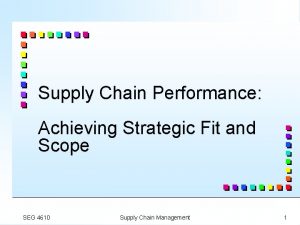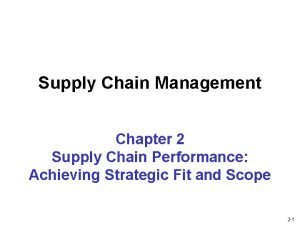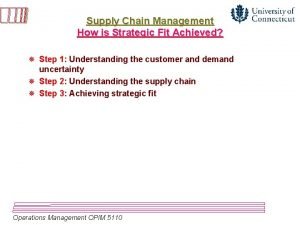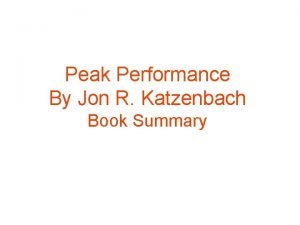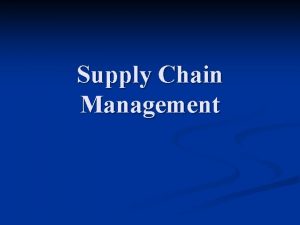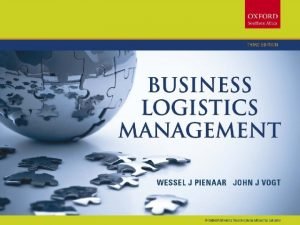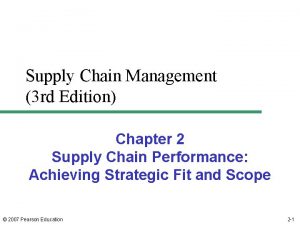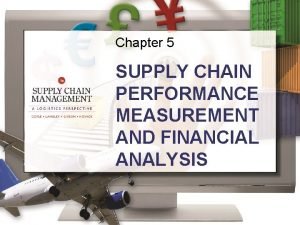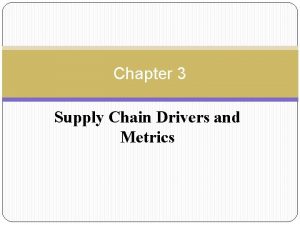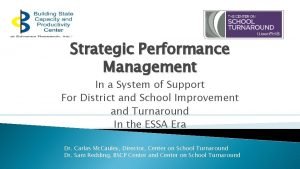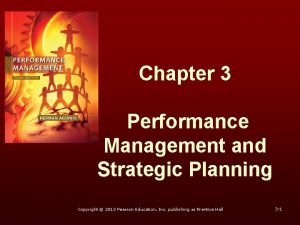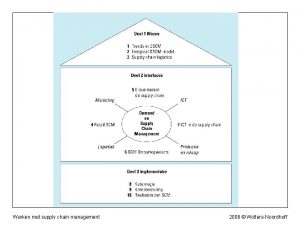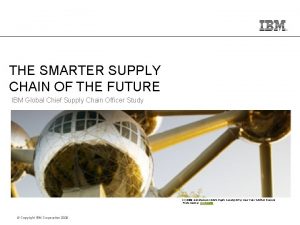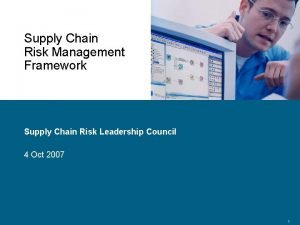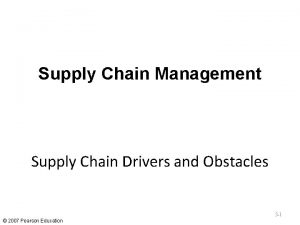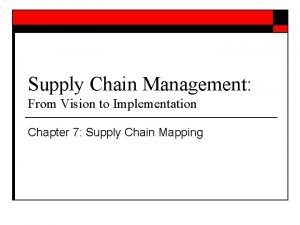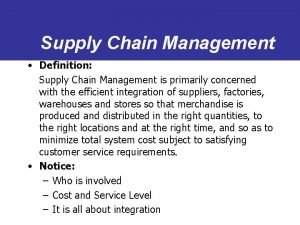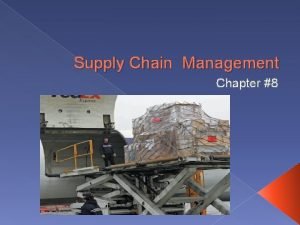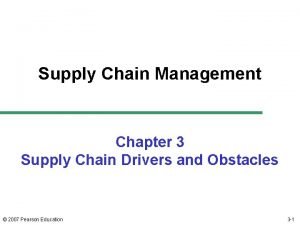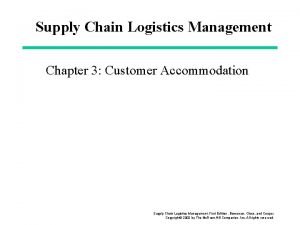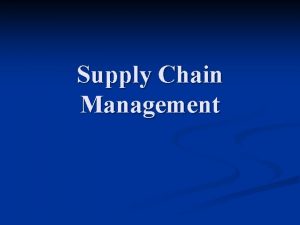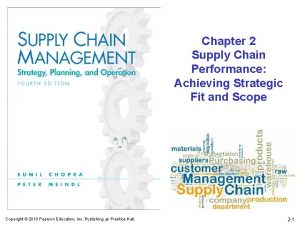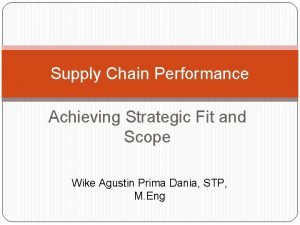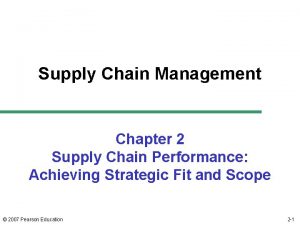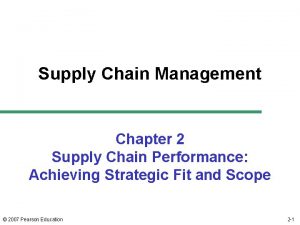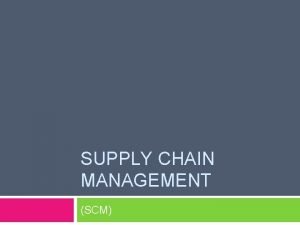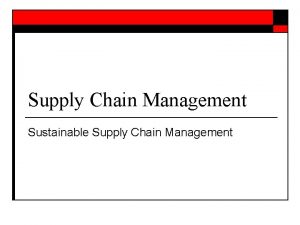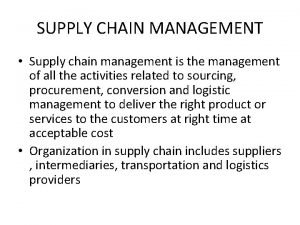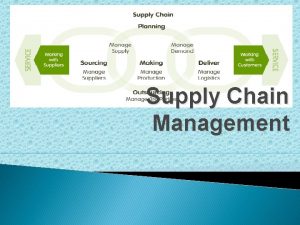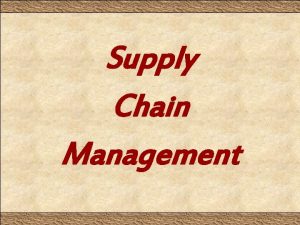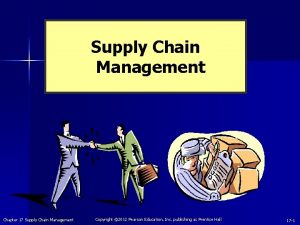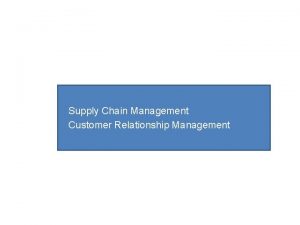Supply Chain Management Supply Chain Performance Achieving Strategic































- Slides: 31

Supply Chain Management Supply Chain Performance: Achieving Strategic Fit and Scope

Outline u. Competitive and supply chain strategies u. Achieving strategic fit

Competitive and Supply Chain Strategies u. Competitive strategy: the set of customer needs a firm seeks to satisfy through its products and services, relative to its competitors. – Wallmart – low price, product availability (Customer: Cost) – Dell – Customization and variety (Customer: Customization) u. Priories of the customer is the determining factor in competitive strategy that how customer prioritizes product cost, delivery time, variety and quality.

Competitive and Supply Chain Strategies u. Supply chain strategy: – Determines the nature of material procurement, transportation of materials, manufacture of product or creation of service, distribution of product. – Determines the broad structure, what the processes within company must focus “to do well”, and what roles each entity in the supply chain should play. – Supply chain strategy is simply the collection of the strategies for new product development, marketing, operations, distributions, and service. – Consistency and support between supply chain strategy, competitive strategy, and other functional strategies is important.

Value Chain u. Support & facilitation Processes. Finance, Accounting, Information Technology, Human Resource New Product Developmen t Marketing & Sales Operations Distribution Service u. Core Processes u. In-house strategy/ Outsource Strategy – CISCO: Component Manufacturing, Assembly System VIEW for organizational profitability. Value chain must function with goal congruence.

Example; 7 - Eleven Japan u. A chain of small stores selling groceries and variety of products and services. u. Competitive strategy; convenience and easy access to stores, availability of variety of products and services (like bill payment). u. Supply chain strategy; emphasizing the convenience and variety in marketing, high density of stores, excellent information system, very responsive forecasting and inventory management system, flexible distribution system in delivery schedules.

Example- Dell u. Competitive strategy; Customization and variety at reasonable price. u. Supply chain strategy; broad structure-direct sale to customer, built-to-order system to achieve the customization and variety, using internet (or phone) and e-business for customization, no finished product inventory, low component inventories, close relations and information sharing with suppliers for speedy delivery and reduced defects, using parcel carriers for speedy delivery, a few assembly plants for economies of scale in production.

Example –Wall Mart u. Competitive strategy; high availability of variety of reasonable quality products at low price. u. Supply chain strategy; frequent replenishment to stores, distribution depots close to store, uses its own fleet for transportation, cross docking strategy at depots, close collaboration and information sharing with its suppliers using their excellent information system.

Achieving Strategic Fit u. Introduction u. How is strategic fit achieved? u. Other issues affecting strategic fit

Achieving Strategic Fit u Strategic fit: – Consistency between customer priorities of competitive strategy that hopes to satisfy and supply chain capabilities that the supply chain strategy aims to build. – Competitive and supply chain strategies should have the same/ alligned goals – All functional strategies that make up the supply chain strategy must be aligned u A company may fail because of a lack of strategic fit or because its processes and resources do not provide the capabilities to execute the desired strategy – Example; Marketing is publicizing product variety and quick delivery while distribution is aiming for low cost means of transportation. (slow modes of transportation, order consolidations)

DELL example for strategic fit u. Competitive strategy; Customization and variety u. Supply chain strategy; – Two extreme options; » Efficient supply chain for low cost products (consolidated production and distribution, dedicated production capacity, limited variety, slow modes of distribution, standard products etc. ) » Responsive supply chain; Flexible production capacity, fast distribution options, product variety, designing easily customizable products with as many as possible common components) – Second option of course better fits with competitive strategy of Dell.

How is Strategic Fit Achieved? u. Step 1: Understanding the customer and supply chain uncertainty u. Step 2: Understanding the supply chain u. Step 3: Achieving strategic fit

Step 1: Understanding the Customer and Supply Chain Uncertainty u. Identify the needs of the customer segment being served – A customer who usually buys detergent from a convenience store v. s. A customer who goes to Metro and buy detergent in larger quantities at cheaper price? – Emergency repair needs v. s. Construction related orders? – What are the characteristics of these types of customers? u. In general customer demand varies in the following attributes; – – – Quantity of product needed in each lot Response time customers will tolerate Variety of products needed Service level required Price of the product Desired rate of innovation in the product

Step 1: Understanding the Customer and Supply Chain Uncertainty u. We will try to combine all of these attributes in one metric; implied demand uncertainty – Demand uncertainty: uncertainty of customer demand for a product – Implied demand uncertainty: » Is demand uncertainty due to the portion of the demand that supply chain is targeting, not the entire demand. u. First step to strategic fit is to understand customers by mapping their demand on the implied uncertainty spectrum

Achieving Strategic Fit u. Understanding the Customer – – – – Lot size Response time Service level Product variety Price Innovation Demand channels Implied Demand Uncertainty

Impact of Customer Needs on Implied Demand Uncertainty (Table 2. 1) Customer Need Causes implied demand uncertainty to increase because … Range of quantity increases Wider range of quantity implies greater variance in demand Lead time decreases Less time to react to orders Variety of products required increases Demand per product becomes more disaggregated Number of channels increases Total customer demand is now disaggregated over more channels Rate of innovation increases New products tend to have more uncertain demand Required service level increases Firm now has to handle unusual surges in demand

Impact of Customer Needs on Implied Demand Uncertainty (Table 2. 1) Customer Need Causes implied demand uncertainty to increase because … Range of quantity increases Wider range of quantity implies greater variance in demand Lead time decreases Less time to react to orders Variety of products required increases Demand per product becomes more disaggregated Number of channels increases Total customer demand is now disaggregated over more channels Rate of innovation increases New products tend to have more uncertain demand Required service level increases Firm now has to handle unusual surges in demand

Levels of Implied Demand Uncertainty

Correlation Between Implied Demand Uncertainty and Other Attributes Let's suppose you are stocking i. Phone 5 s for sale. You project your sales and then you look at how much of that your supply chain can cover. For example, you are in a large metro area and can sell 50, 000 i. Phone 5 s but the lousy supplier will give you only 30, 000 i. Phone 5 s. That means the maximum number of customers you can handle is 30, 000. Let's say that you do a little looking at trends and such and you determine that 25% of your customers have to upgrade to the i. Phone 5 due to work requirements (perhaps phone security). Then 75% of your sales will be due to the customer's desire to have the latest Apple phone. So. . . . Your implied demand uncertainty is 75% of 30, 000. That is, if the reviews are bad or the customers decide the i. Phone 4 is fine, then you could have (75% of 30, 000) i. Phone 5 s in stock that you can't sell.

Step 2: Understanding the Supply Chain u. How does the firm best meet demand? u. Dimension describing the supply chain is supply chain responsiveness u. Supply chain responsiveness -- ability to – – – respond to wide ranges of quantities demanded meet short lead times handle a large variety of products build highly innovative products Handle supply problems (yield, untimely delivery of components, breakdowns etc. )

Step 2: Understanding the Supply Chain u. There is a cost to achieving responsiveness u. Increasing responsiveness results in higher costs that lower efficiency u. Second step to achieving strategic fit is to map the supply chain on the responsiveness spectrum

Responsiveness Spectrum (Figure 2. 4) Highly efficient Integrated steel mill Advance Production Schedules, Less variety and flexibilty Somewhat efficient Hanes Apparel Make to stock manufacurer with a lead time in weeks Somewhat responsive Most automotive Production Variety of products delivered in weeks Highly responsive Seven-Eleven Japan Variety of products by locaiton and by the time of the day, quick replenishments

Examples u Responsive supply chains; – 7 Eleven- Japan; , » variety of products; replenishes stores three times a day, with breakfast items, lunch items, and dinner items, provide different services. » Short lead times; a store is replenished in less then 12 hours after the store manager gives an order. – Dell » Variety of products; customers designs their own PCs. » Short lead times; uses parcel carriers for transportation to deliver a PC to the customer in a week on the average. u Efficient supply chain; – BİM stores » Less workers at stores, less promotional costs, displaying products in boxes rather than stacking them on shelves, limited variety (about 600), reasonable quality products, stores not on main streets but in secondary places to keep the costs down.

Step 3: Achieving Strategic Fit u Step is to ensure that what the supply chain does well (supply chain strategy) is consistent with target customer’s needs (competitive strategy) u Fig. C: Zone of strategic fit u Examples: – Dell; High implied demand uncertainty and responsive supply chain – Barilla (Italian pasta manufacturer); Low level of demand uncertainty and efficient supply chain

Achieving Strategic Fit Shown on the Uncertainty/Responsiveness Map (Fig. C) Responsive supply chain of it e n ic F o Z teg ra t S Responsiveness spectrum Efficient supply chain Certain demand Implied uncertainty spectrum Uncertain demand

Step 3: Achieving Strategic Fit u In achieving strategic fit, different levels in the supply chain can be assigned different responsiveness and efficiency. u Examples; – IKEA; Swedish furniture retailer » Targets customer who wants stylish furniture at reasonable price » Limited variety to reduce the supply uncertainty » Large stores where all styles are stocked and customer demand is satisfied from stocks. » Stable and predictable orders to its manufacturers located in low-cost countries. » Responsiveness provided by the stocks in store that absorbs the demand uncertainty. » Manufacturers can be efficient because of stable and predictable

Step 3: Achieving Strategic Fit u Example; – England Inc. ; Furniture manufacturer in Tennessee – England manufactures and delivers thousand of sofas and chairs to orders with three weeks lead time. – England’s retailers let customer to select from variety of products with a promise of quick delivery. Retailers carry little inventory – All the uncertainty is passed to England Inc. And Retailers can be efficient – England Inc. can either hold high levels of raw material inventories to absorb the uncertainty and chose not to be efficient and allows its suppliers to be efficient, or passes all the uncertainty to its suppliers by holding low levels of raw materials and England itself works efficiently.

Step 3: Achieving Strategic Fit u. Two key points – there is no right supply chain strategy independent of competitive strategy – there is a right supply chain strategy for a given competitive strategy

Comparison of Efficient and Responsive Supply Chains Efficient Responsive Primary goal Lowest cost Quick response Product design strategy Min product cost Room to allow postponement Pricing strategy Lower margins Higher margins Mfg strategy High utilization Capacity flexibility Inventory strategy Minimize inventory Buffer inventory Lead time strategy Reduce but not at expense of Aggressively reduce even if greater costs are significant Supplier selection strategy Cost and low quality Speed, flexibility, quality Transportation strategy Greater reliance on low cost modes Greater reliance on responsive (fast) modes

Assignment # 1 Q: Explain Why achieving strategic fit is critical to a company’s overall success. Q: Describe how a company achieve strategic fit between SC Strategy & Competitive Strategy. For Bonus Marks: Email before Friday 11: 59 PM to me directly (+2 Bonus marks) Submit hardcopies in next class.

Case Study Bullwhip Effect 2 -31
 Scope of strategic fit
Scope of strategic fit Scope of strategic fit
Scope of strategic fit Achieving strategic fit in supply chain
Achieving strategic fit in supply chain Peak performance book summary
Peak performance book summary Types of e crm
Types of e crm Enterprise resource planning ppt
Enterprise resource planning ppt What is the correct sequence in supply chain
What is the correct sequence in supply chain Logistics/supply chain strategy and planning
Logistics/supply chain strategy and planning Cost responsiveness efficient frontier
Cost responsiveness efficient frontier Io model strategic management
Io model strategic management Strategic analysis and choice in strategic management
Strategic analysis and choice in strategic management Financial measures of supply chain performance
Financial measures of supply chain performance Drivers of supply chain management
Drivers of supply chain management Strategic management performance system
Strategic management performance system Performance management and strategic planning
Performance management and strategic planning Matching supply with demand
Matching supply with demand The role of project management in achieving project success
The role of project management in achieving project success Chapter 11 performance appraisal - (pdf)
Chapter 11 performance appraisal - (pdf) Behaviorally anchored rating scale
Behaviorally anchored rating scale Difference between logistics and supply chain
Difference between logistics and supply chain Grazing food chain diagram
Grazing food chain diagram Werken met supply chain management
Werken met supply chain management Ibm supply chain risk management
Ibm supply chain risk management Supply chain risk management framework
Supply chain risk management framework Supply chain risk management framework
Supply chain risk management framework Supply chain cisco
Supply chain cisco Drivers of supply chain management
Drivers of supply chain management Pipeline in supply chain
Pipeline in supply chain Supply chain management meaning and definition
Supply chain management meaning and definition Order promising module of supply chain management
Order promising module of supply chain management Drivers in supply chain
Drivers in supply chain Customer accomodation
Customer accomodation
